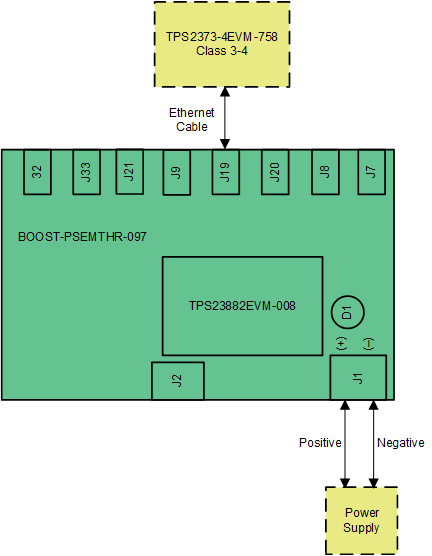SLVUC36 April 2021 TPS23882B
- Trademarks
- 1Description
- 2Quick Start
- 3General Use Features
- 4TPS23882B1 GUI Setup
- 5EVM Schematic, Layout Guidelines, PCB Assembly and Layer Plots
- 6Bill of Materials
2.4 Basic Test Setup Using Autonomous Mode
The TPS23882B1 supports autonomous mode which means it can operate without any host control. During power up the resistance on the AUTO pin is measured and the device is pre-configured according to the jumper configuration on J5 of the daughterboard. All ports are configured with the same power level. Due to the hardware configuration on the motherboard, all 2-pair ports are interoperable with PDs. Only 2P-15W and 2P-30W are valid selections on the TPS23882B1EVM-008 as the other resistors are not populated.
To test with autonomous mode, install a jumper on the pins of J5 corresponding to the desired power level and power on the board without the USB2ANY or MSP-EXP430FR5969 connected. Figure 2-1 illustrates the basic setup using autonomous mode.
 Figure 2-1 Basic Setup Using Autonomous Mode
Figure 2-1 Basic Setup Using Autonomous ModeIf the EVM is powered with a jumper on J5 of the daughterboard, the device will automatically enter autonomous mode at the selected power level. If the selected power level changes, the EVM must be power cycled for the change to take effect.
| AUTO Pin | Autonomous Mode Configuration | Resulting Register Configurations | ||
|---|---|---|---|---|
| Register 0x12h | Register 0x14h | Register 0x29h | ||
| Open/Floating | Disabled | 0x00h | 0x00h | 0x00h |
| 124 kΩ | 2-pair 15 W | 0xFFh | 0xFFh | 0x00h |
| 62 kΩ | 2-pair 30 W | 0xFFh | 0xFFh | 0x33h |